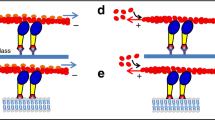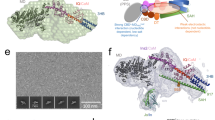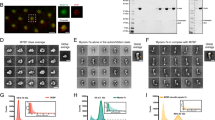Abstract
Myosins constitute a superfamily of at least 18 known classes of molecular motors that move along actin filaments1,2,3. Myosins move towards the plus end of F-actin filaments; however, it was shown recently that a certain class of myosin, class VI myosin, moves towards the opposite end of F-actin, that is, in the minus direction4. As there is a large, unique insertion in the myosin VI head domain between the motor domain and the light-chain-binding domain (the lever arm), it was thought that this insertion alters the angle of the lever-arm switch movement, thereby changing the direction of motility4. Here we determine the direction of motility of chimaeric myosins that comprise the motor domain and the lever-arm domain (containing an insert) from myosins that have movement in the opposite direction. The results show that the motor core domain, but neither the large insert nor the converter domain, determines the direction of myosin motility.
This is a preview of subscription content, access via your institution
Access options
Subscribe to this journal
Receive 51 print issues and online access
$199.00 per year
only $3.90 per issue
Buy this article
- Purchase on Springer Link
- Instant access to full article PDF
Prices may be subject to local taxes which are calculated during checkout


Similar content being viewed by others
References
Mooseker, M. S. & Cheney, R. E. Unconventional myosins. Annu. Rev. Cell Dev. Biol. 11, 633–675 (1995).
Titus, M. A. Unconventional myosins: new frontiers in actin-based motors. Trends Cell Biol. 7, 119–123 (1997).
Hodge, T. & Cope, M. J. A myosin family tree. J. Cell Sci. 113, 3353–3354 (2000).
Wells, A. L. et al. Myosin VI is an actin-based motor that moves backwards. Nature 401, 505–508 (1999).
Kellerman, K. A. & Miller, K. G. An unconventional myosin heavy chain gene from Drosophila melanogaster. J. Cell Biol. 119, 823–834 (1992).
Hasson, T. & Mooseker, M. S. Porcine myosin VI: characterization of a new mammalian unconventional myosin. J. Cell Biol. 127, 425–440 (1994).
Hasson, T. et al. Unconventional myosin in inner ear sensory epithelia. J. Cell Biol. 137, 1287–1307 (1997).
Baker, J. P. & Titus, M. A. A family of unconventional myosins from the nematode Caenorhabditis elegans. J. Mol. Biol. 272, 523–535 (1997).
Mermall,V., McNally, J. G. & Miller, K. G. Transport of cytoplasmic particle catalyzed by an unconventional myosin in living Drosophila embryo. Nature 369, 560–562 (1994).
Avraham, K. B. et al. The mouse Snell's walzer deafness gene encodes an unconventional myosin required for structural integrity of inner ear hair cells. Nature Genet. 11, 369–375 (1995).
Kelleher, J. F. et al. Myosin VI is required for asymmetric segregation of cellular components during C. elegans spermatogenesis. Curr. Biol. 10, 1489–1496 (2000).
Mehta, A. D. et al. Myosin-V is a processive actin-based motor. Nature 400, 590–593 (1999).
Walker, M. L. et al. Two-headed binding of a processive myosin to F-actin. Nature 405, 804–807 (2000).
Sakamoto, T., Amitani, I., Yokota, E. & Ando, T. Direct observation of processive movement by individual myosin V molecules. Biochem. Biophys. Res. Commun. 272, 586–590 (2000).
Endow, S. A. & Waligora, K. W. Determination of kinesin motor polarity. Science 281, 1200–1202 (1998).
Sablin, E. P. et al. Direction determination in the minus-end-directed kinesin motor ncd. Nature 395, 813–816 (1998).
Endow, S. A. & Higuchi, H. A mutant of the motor protein kinesin that moves in both directions on microtubules. Nature 406, 913–916 (2000).
Houdusse, A., Kalabokis,V. N., Himmel, D., Szent-Gyorgyi, A. G. & Cohen, C. Atomic structure of scallop myosin subfragment S1 complexed with MgADP: a novel conformation of the myosin head. Cell 97, 459–470 (1999).
Dominguez, R., Freyzon, Y., Trybus, K. M. & Cohen, C. Crystal structure of a vertebrate smooth muscle myosin motor domain and its complex with the essential light chain: visualization of the pre-power stroke state. Cell 94, 559–571 (1998).
Smith, C. A. & Rayment, I. X-ray structure of the magnesium(II).ADP.vanadate complex of the Dictyostelium discoideum myosin motor domain to 1.9 Å resolution. Biochemistry 35, 5404–5417 (1996).
Spudich, J. A. & Watt, J. The regulation of rabbit skeletal muscle contraction. I. Biochemical studies of the interaction of the tropomyosin-troponin complex with actin and the proteolytic fragments of myosin. J. Biol. Chem. 246, 4866–4871 (1971).
Chien, Y. H. & Dawid, I. B. Isolation and characterization of calmodulin genes from Xenopus laevis. Mol. Cell. Biol. 4, 507–513 (1984).
Zhu, T., Sata, M. & Ikebe, M. Functional expression of mammalian myosin Iβ: analysis of its motor activity. Biochemistry 35, 513–522 (1996).
Homma, K., Saito, J., Ikebe, R. & Ikebe, M. Ca2+ dependent regulation of the motor activity of myosin V. J. Biol. Chem. 275, 34766–34771 (2000).
Ikebe, M. & Hartshorne, D. J. Effects of Ca2+ on the conformation and enzymatic activity of smooth muscle myosin. J. Biol. Chem. 260, 13146–13153 (1985).
Sata, M., Matsuura, M. & Ikebe, M. Characterization of the motor and enzymatic properties of smooth muscle long S1 and short HMM: role of the two-headed structure on the activity and regulation of the myosin motor. Biochemistry 35, 11113–11118 (1996).
Acknowledgements
We thank N. Jenkins and K. Avraham for sending us the cDNA fragments of mouse myosin V and mouse myosin VI. We also thank D. J. Schmidt for reading the manuscript.
Author information
Authors and Affiliations
Rights and permissions
About this article
Cite this article
Homma, K., Yoshimura, M., Saito, J. et al. The core of the motor domain determines the direction of myosin movement. Nature 412, 831–834 (2001). https://doi.org/10.1038/35090597
Received:
Accepted:
Issue Date:
DOI: https://doi.org/10.1038/35090597
This article is cited by
-
Phospholipid-dependent regulation of the motor activity of myosin X
Nature Structural & Molecular Biology (2011)
-
Dynamic polymorphism of single actin molecules in the actin filament
Nature Chemical Biology (2006)
-
The structure of the myosin VI motor reveals the mechanism of directionality reversal
Nature (2005)
-
Molecular engineering of a backwards-moving myosin motor
Nature (2004)
-
Molecular motors
Nature (2003)
Comments
By submitting a comment you agree to abide by our Terms and Community Guidelines. If you find something abusive or that does not comply with our terms or guidelines please flag it as inappropriate.



